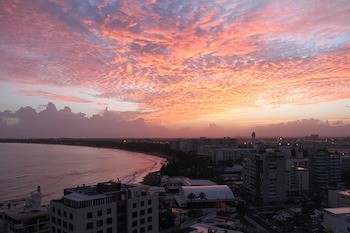

September 4, 2018
As we near the one-year anniversary of the devastation Hurricane Maria afflicted upon the residents of Puerto Rico, it’s concerning that post-hurricane efforts have been largely focused on restoring power with little progress on strengthening the already-weakened power grid against a future storm.
A variety of narrowly focused renewable energy solutions have been presented in recent months, with uncertain efficacy toward helping Puerto Rico’s grid withstand another direct strike from mother nature.

San Juan, Puerto Rico
However, in the recently issued whitepaper “Resilient by Design: Enhanced Reliability and Resiliency for Puerto Rico’s Electric Grid,” we’ve detailed how a holistic mini-grid solution balancing cost, reliability and resilience – leveraging renewable power generation and storage resources – can inform a new approach to ultimately save lives by shortening recovery times in the event of catastrophic events.
The solution shows how the introduction of 10 mini-grids, capable of operating both grid-connected and in island modes would create “islands with an island.” These separate geographic “pockets” of loads would be served by distributed generation and storage resources, improving resilience by reducing dependency on a few centralized power assets. They would be integrated during normal operations but could be segmented in the event of disruptions or emergencies.
As a key point of reference, mini-grids are different from microgrids in that they utilize existing distribution infrastructure and can be sized much larger than typical microgrids, for example, one mini-grid could encompass the entire San Juan region.
At the heart of the strategy is an analysis of the often-competing objectives of cost, reliability and resiliency. There is a “base case” plan that focuses on cost and reliability and a comparison plan that is a more resilient “enhanced case” approach – clearly necessitated by Hurricanes Irma and Maria in 2017. These two scenarios help determine how supply would have to be modified and redesigned or moved to add greater resiliency.
The base case leverages a mini-grid strategy to improve resiliency while still incorporating conventional power generation hubs in the north and south of the island. The base case strategy achieves 20 percent renewable energy mix, including large and small combined cycle gas turbines, solar photovoltaic and battery-based energy storage. The more resilient enhanced case provides more distributed energy resources (DER) enabling the grid to reach 35 percent renewable energy integration, with a lower-emissions mix of generation resources that include more energy storage, distributed solar and small CCGT units, all strategically placed to form the 10 proposed mini-grids.
The enhanced case strategy provides critical energy resilience against high impact events to the grid through a greater use of DER including solar PV and storage – shifting daytime production to serve the night peak loads – as well as incorporating the hardening of power generation assets, such as designing PV resources to withstand Category 4 hurricanes.
While the enhanced case results in a slightly higher levelized cost of energy – seven percent higher than the base strategy – it would seem to be a relatively small price to pay for the benefits the mini-grid approach would offer. Installing a more resilient renewable energy system on the island would offer a true return on investment to all stakeholders by avoiding extremely costly outages, and simplifying restoration efforts. In reality, the seven percent is conservative, since it compares normal operating cases only, and, does not factor in avoided costs of recovery in the event of a disaster, or likely reduced transmission costs.
With the Caribbean in the midst of another hurricane season – and so much yet to be done to avoid a repeat of 2017 – a comprehensive approach is more important now than ever to protect lives, and ensure the island’s citizens and businesses will be able to resume a routine way of life more quickly in the wake of future weather events. Renewable Energy World, by Matt Martinez, Siemens Contributor
Murphy International
Development, LLC
65 Redding Road
Georgetown, CT
06829-0807 USA
phone: (203) 544-8303
info@murphyintldev.com
Murphy International Development services independent power producers and developers of renewable and conventional plants including; solar, wind, Biomass, hydroelectric, geothermal, CHP, cogeneration and alternative fuels projects.
